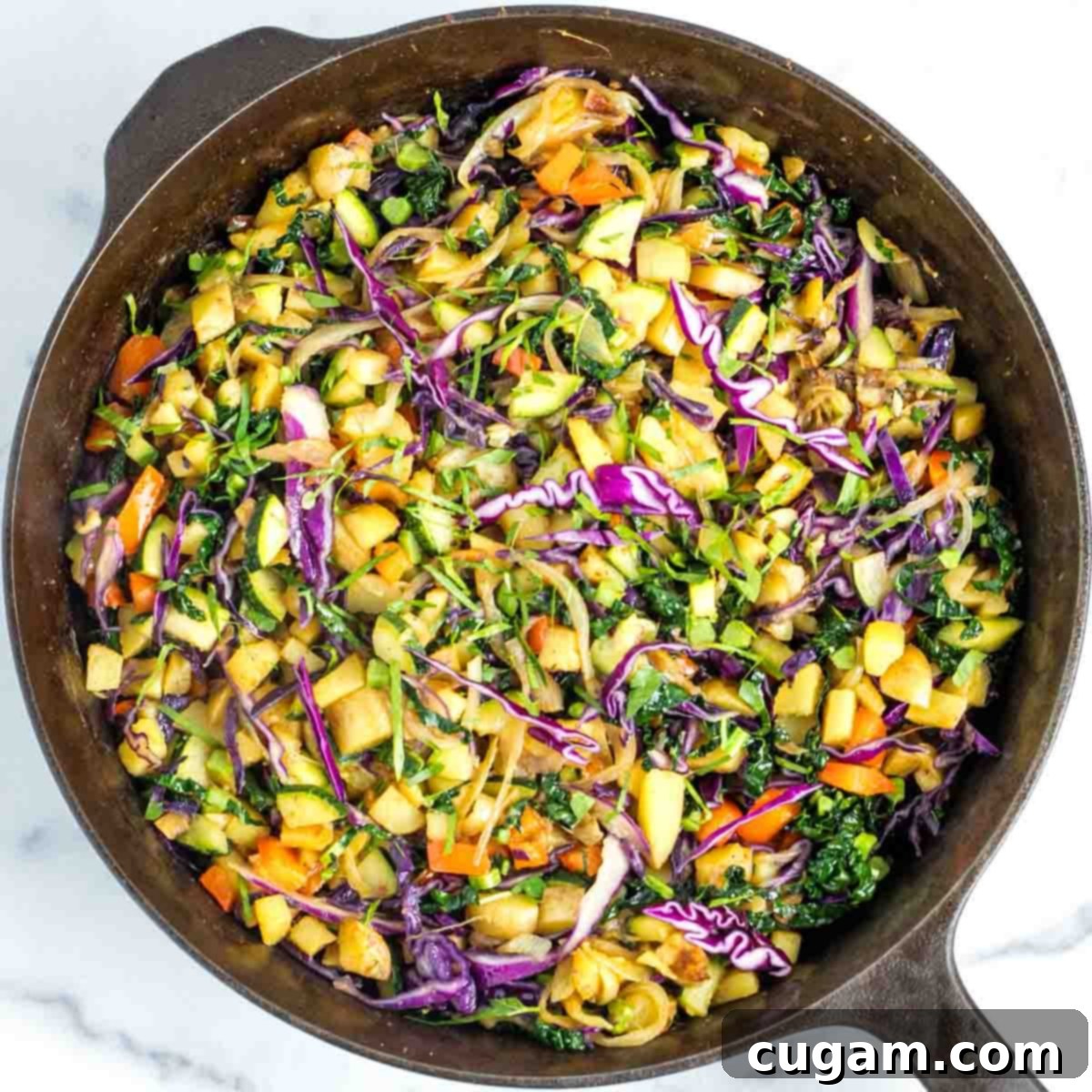Easy & Delicious Vegan Potato and Veggie Hash Skillet Recipe (Healthy & Quick!)
Prepare to fall in love with this incredibly delicious and remarkably easy Vegan Potato and Veggie Hash! This recipe is a true game-changer, offering a wholesome, satisfying, and quick meal that’s incredibly versatile. Crafted in a single skillet, this vibrant breakfast hash (or any-time hash!) brings together a delightful array of colorful vegetables and perfectly cooked potatoes. Think of it as the cooked, cozy version of a fantastic chopped salad – where every single bite delivers a burst of diverse flavors and textures. Whether you’re a seasoned vegan or simply looking to incorporate more plant-based meals into your diet, this recipe promises to be a staple in your kitchen.
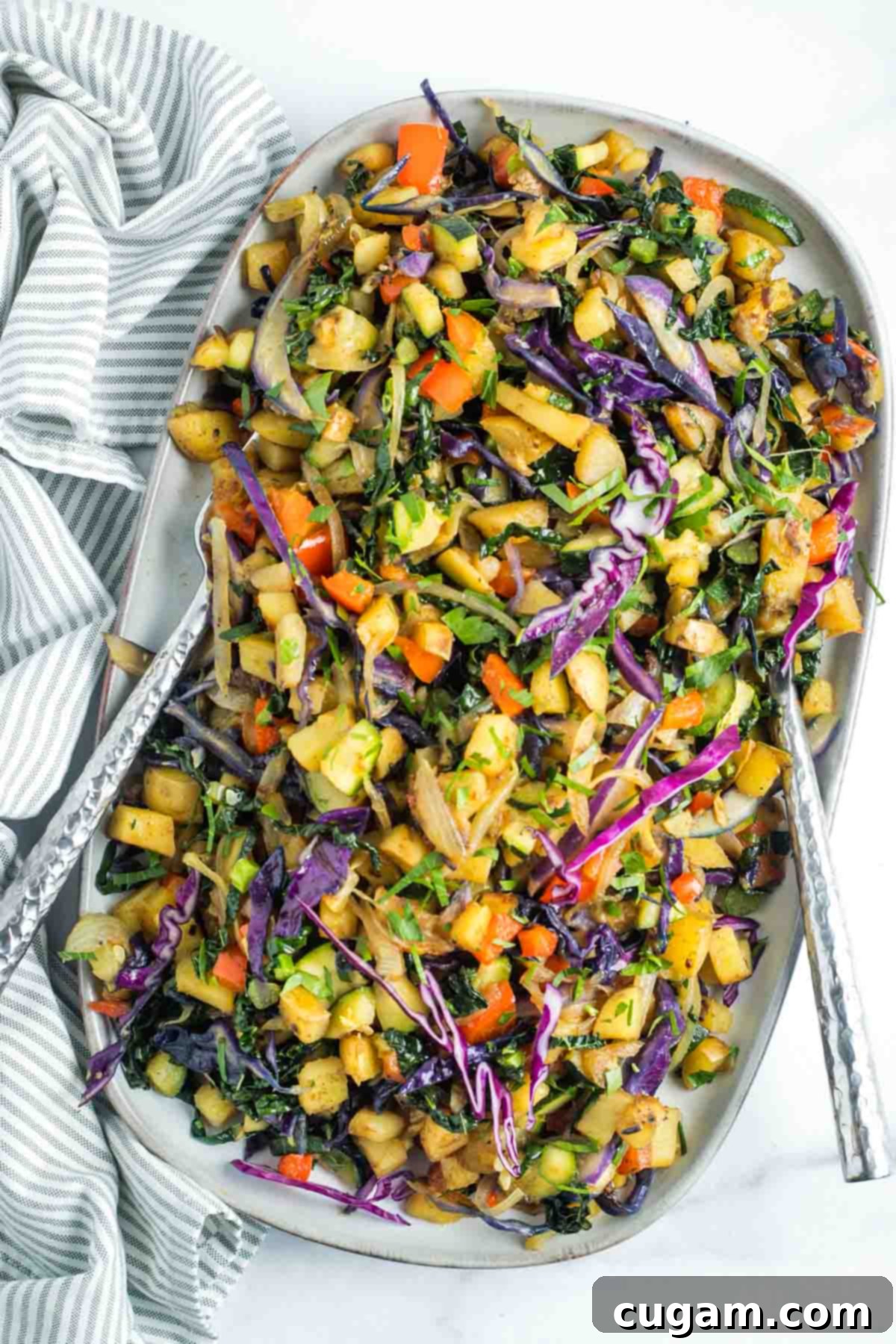
Vegan Veggie Hash: Your Go-To Meal for Any Time of Day
One of the many reasons to adore this vegan potato and veggie hash is its incredible versatility. It’s not just a breakfast dish; it’s a culinary chameleon that adapts seamlessly to any meal and even makes excellent meal prep. You can enjoy it warm, at room temperature, or even cold, making it perfect for grab-and-go options. Reheating this Potato and Vegetable Hash is a breeze: a quick refresh in a hot skillet helps to re-caramelize those delicious potatoes and onions, bringing back their crisp texture. Alternatively, pop it into a 350-degree oven for about 15 minutes until thoroughly heated.
- Energizing Breakfast: Elevate your morning routine by reheating your hash in a skillet over medium heat. Pair it with protein-packed additions like black beans, lentils, or a savory scrambled tofu. Top with fresh avocado slices and a dash of your favorite hot sauce for an extra kick!
- Quick & Healthy Lunch: Say goodbye to boring lunches! Scoop a generous portion of this hearty hash onto a simple green salad. The hash adds a burst of flavor, texture, and nutrition, transforming a plain salad into a satisfying and exciting meal. It’s also fantastic simply packed in a container for a warm or cold office lunch.
- Vibrant Dinner Side or Main: This potato and veggie hash shines as a quick and easy side dish for any dinner. Its rich flavors and colorful presentation complement a variety of main courses. To make it a complete vegan dinner, consider adding more plant-based protein like chickpeas, pan-seared tempeh, or a vegan sausage, turning this humble hash into a fulfilling main course.
- Endless Vegetable Possibilities: The beauty of this recipe lies in its adaptability to whatever you have on hand. Don’t be afraid to experiment with vegetables from your crisper drawer! This includes leftover cooked veggies from previous meals, minimizing food waste and maximizing flavor. Think broccoli florets, carrots, spinach, mushrooms, or even leftover roasted root vegetables.
Essential Ingredients for Your Vegan Hash Skillet
Crafting a truly flavorful vegan potato and veggie hash starts with selecting the right ingredients. This recipe is designed to be flexible, but here are the core components that create its delicious foundation:
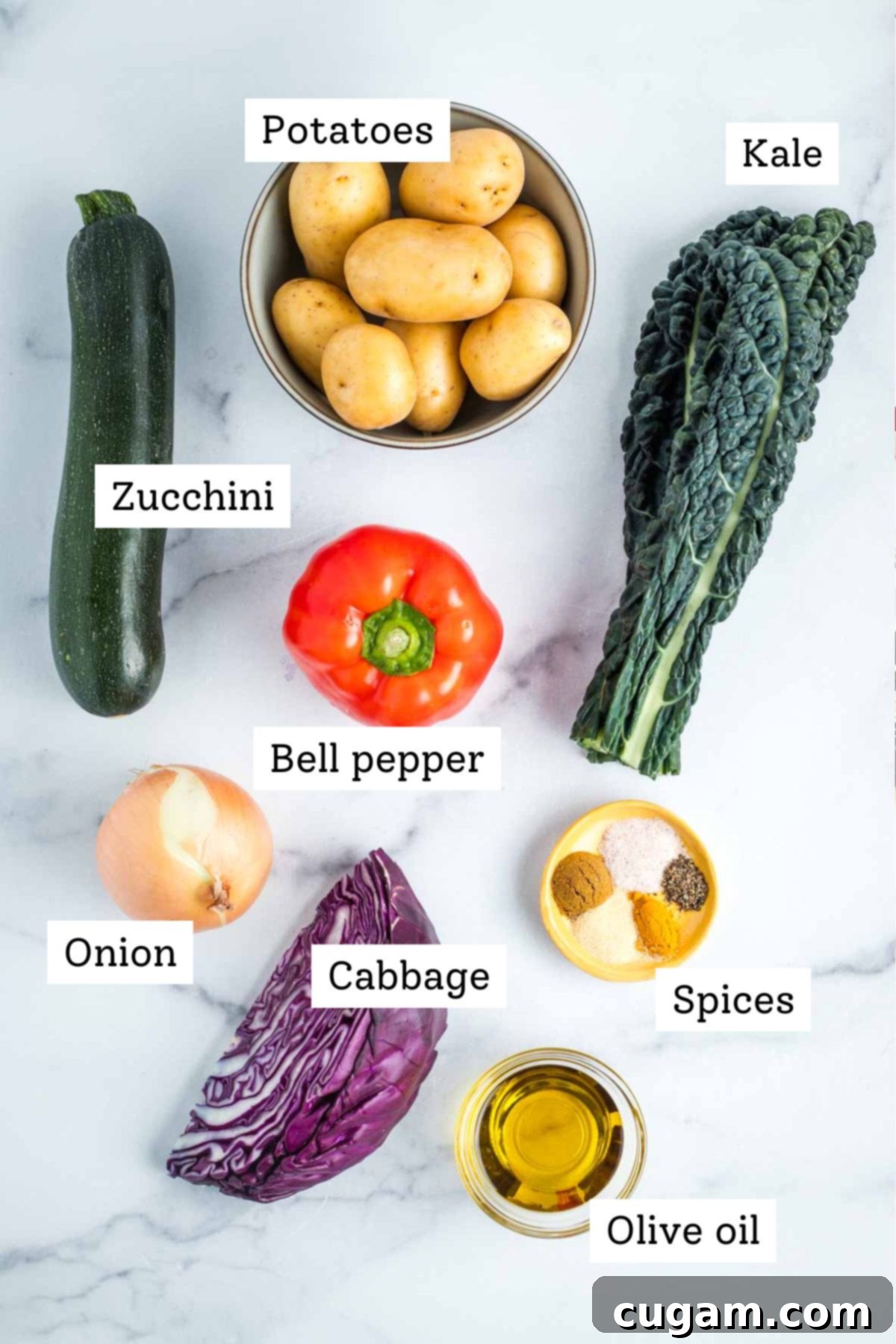
- Potatoes: The foundation of any good hash! Yukon Gold potatoes are excellent for their creamy texture and ability to crisp up beautifully. Russets or Idaho potatoes will also work wonderfully, offering a slightly starchier texture. For a different twist and added sweetness, feel free to substitute with sweet potatoes – they caramelize fantastically.
- Kale: Lacinato kale (also known as Dinosaur kale) is highly recommended for this recipe. Its flatter leaves are easiest to thinly slice, allowing it to wilt perfectly into the hash while retaining a slight bite. If Lacinato isn’t available, curly kale works too, just ensure it’s finely chopped.
- Cabbage: Look for a cabbage that feels heavy for its size; this indicates it’s more compact and will yield nice, thin ribbons when sliced. While purple cabbage adds a stunning pop of color and a mild peppery note, green cabbage is a perfectly good alternative and will still contribute a lovely texture. You can slice it into thin ribbons or cut it into small cubes, depending on your preference.
- Olive Oil: Essential for achieving that desirable crispiness and rich flavor in your potatoes and onions. If you’re aiming for an oil-free hash, you can sauté all the vegetables using water or vegetable broth. Just be aware that the potatoes and onions may not develop the same level of caramelization and crispness without the oil. Use a good quality non-stick pan and add small splashes of liquid as needed to prevent sticking.
- Spices: The chosen spice blend offers a wonderful Mediterranean profile, combining earthy cumin, vibrant turmeric, and aromatic garlic powder. These spices not only add incredible depth of flavor but also bring beneficial properties. For a different culinary journey, consider a Mexican flair with taco seasoning, or an Italian blend with oregano, basil, and thyme. Don’t forget a good pinch of sea salt and freshly ground black pepper to taste, as these are crucial for enhancing all the other flavors.
Mastering Your Mise en Place: Preparing the Vegetables
Efficient meal preparation, or “mise en place,” is key to making this vegan potato and veggie hash come together quickly and smoothly. Before you even turn on the stove, ensure all your vegetables are prepped and your spices measured out. A crucial tip: save cutting the potatoes for last. This prevents them from oxidizing and turning brown while you prepare the other ingredients. If you do need to chop everything ahead of time, simply place the cubed potatoes in a bowl of cold water to keep them fresh, then drain them thoroughly just before adding them to the skillet.
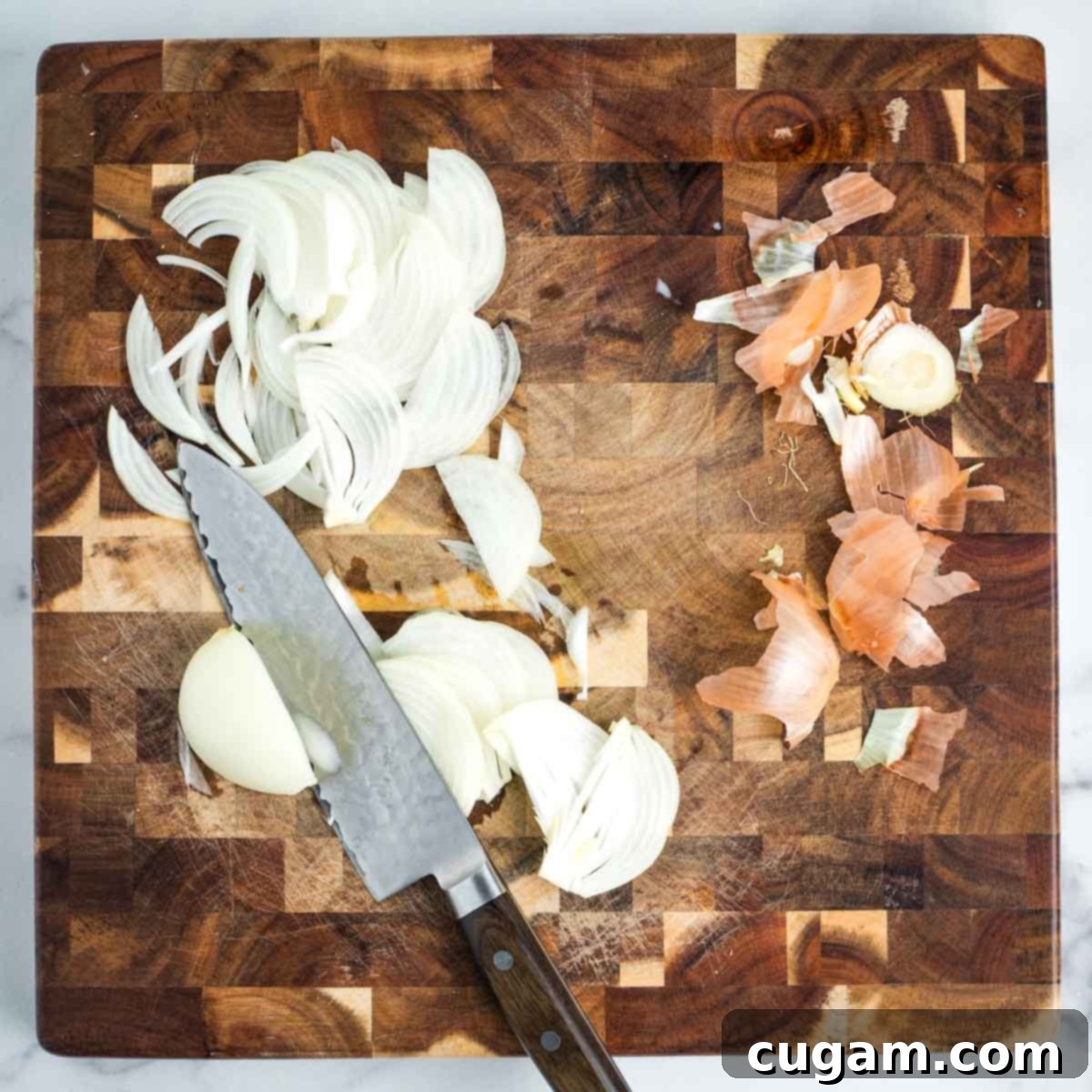
To prepare the onion, cut it in half through the stem end. Discard the outer skin layers. Place each half cut-side down on your cutting board and, using a sharp knife, make thin, even slices. This ensures consistent cooking and beautiful caramelization.
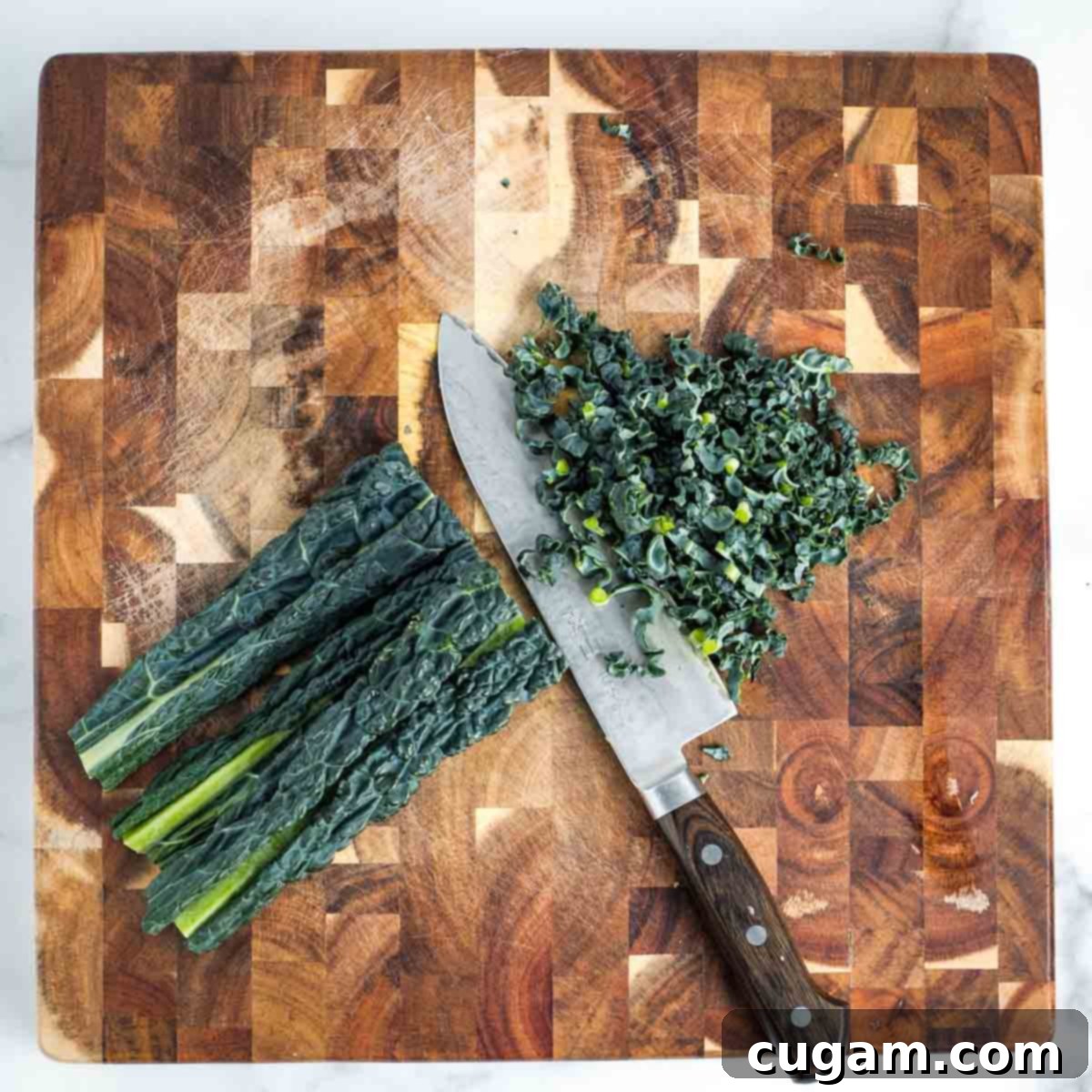
Wash the kale thoroughly and pat it dry with a towel to remove excess moisture. Stack the leaves neatly, then roll them up tightly before slicing them as thinly as possible into ribbons. This technique helps the kale wilt quickly and evenly.
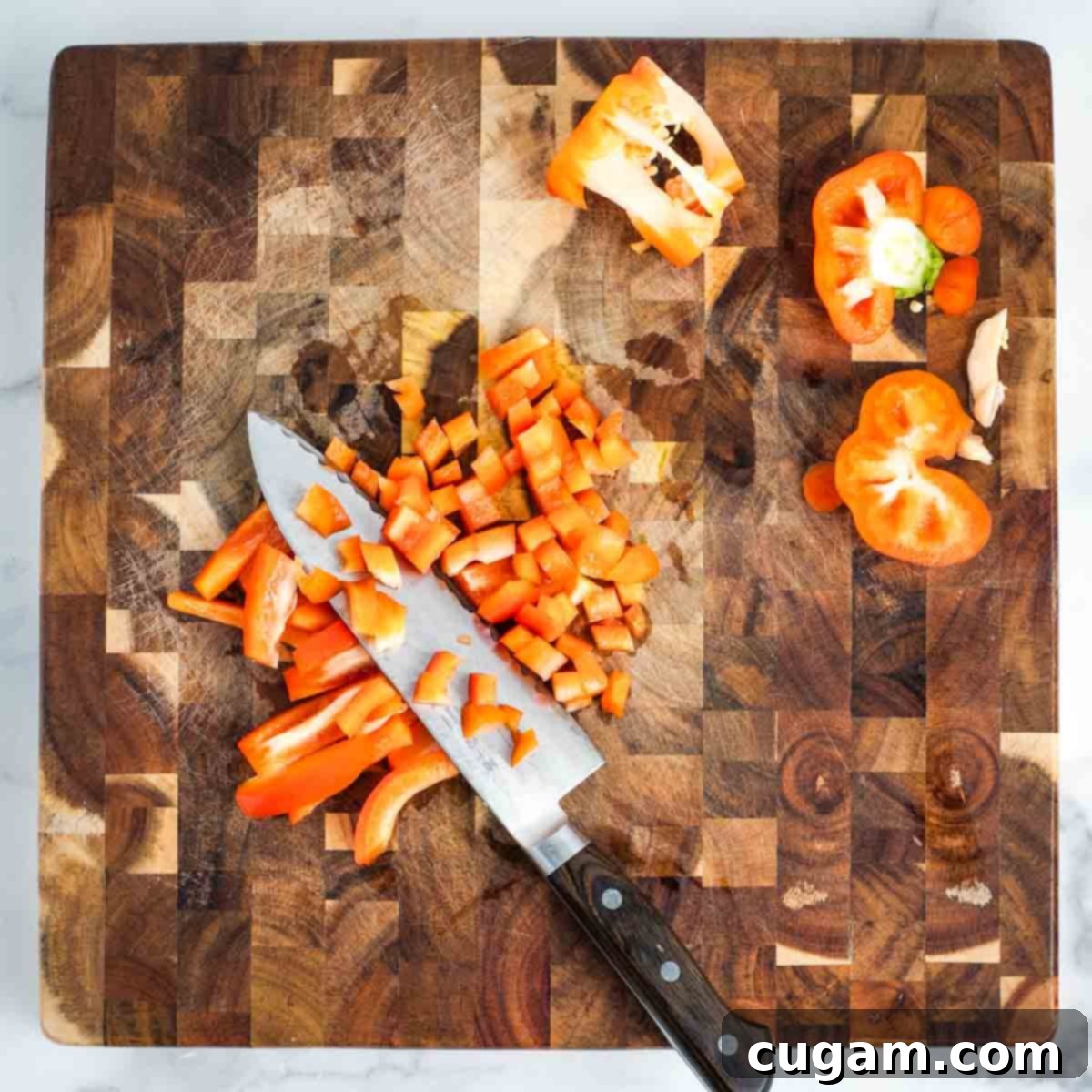
Begin by cutting off the top and bottom ends of the bell pepper. Remove and discard the inner core and seeds. Cut the pepper into thin strips, then rotate and cut across the strips to create small, uniform cubes. This ensures they cook at a similar rate to other diced vegetables.
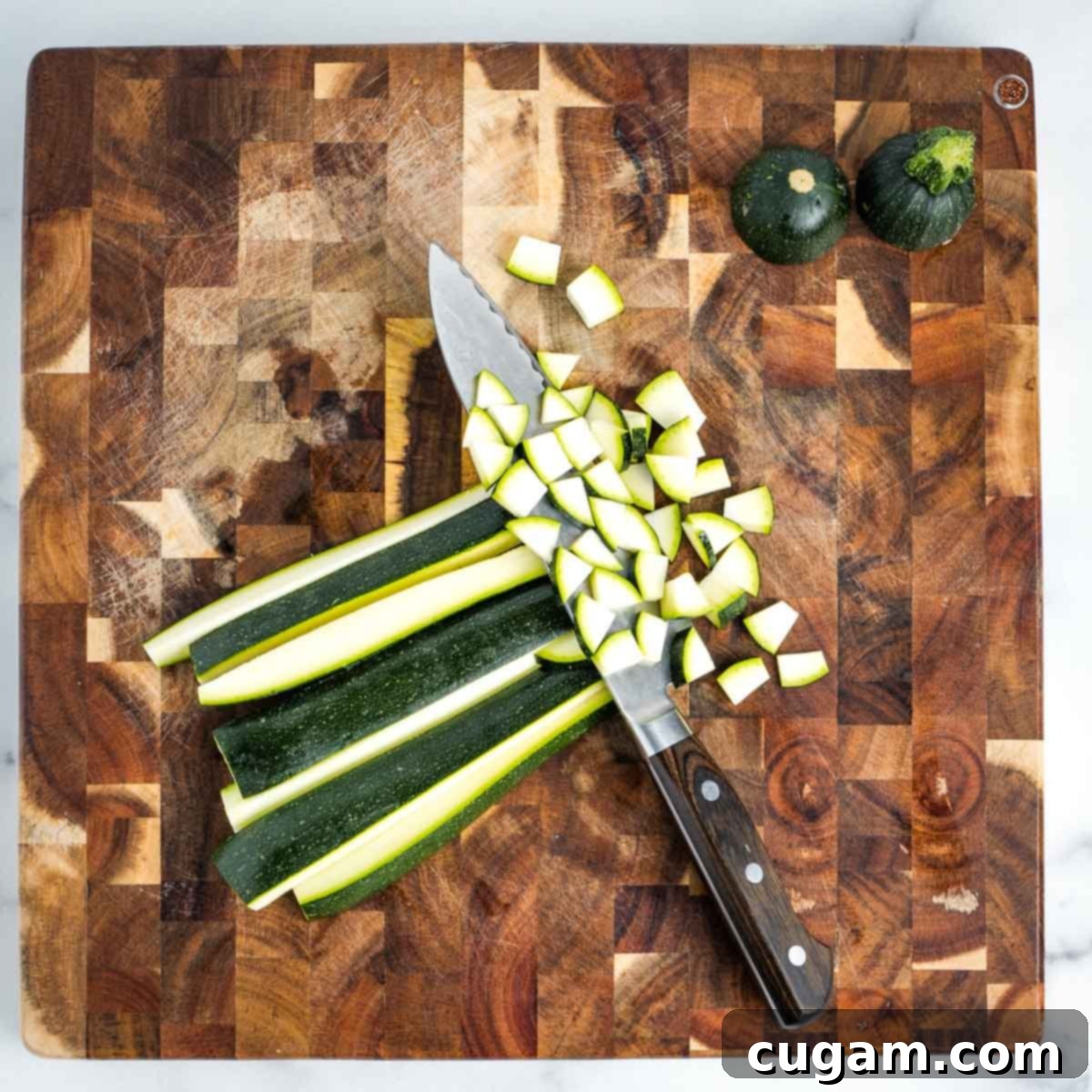
Trim the ends off the zucchini. Slice the zucchini into long, even strips. Then, turn the strips and cut across them to form small, consistent cubes. Dicing all vegetables to a similar size is key for even cooking and a cohesive hash texture.
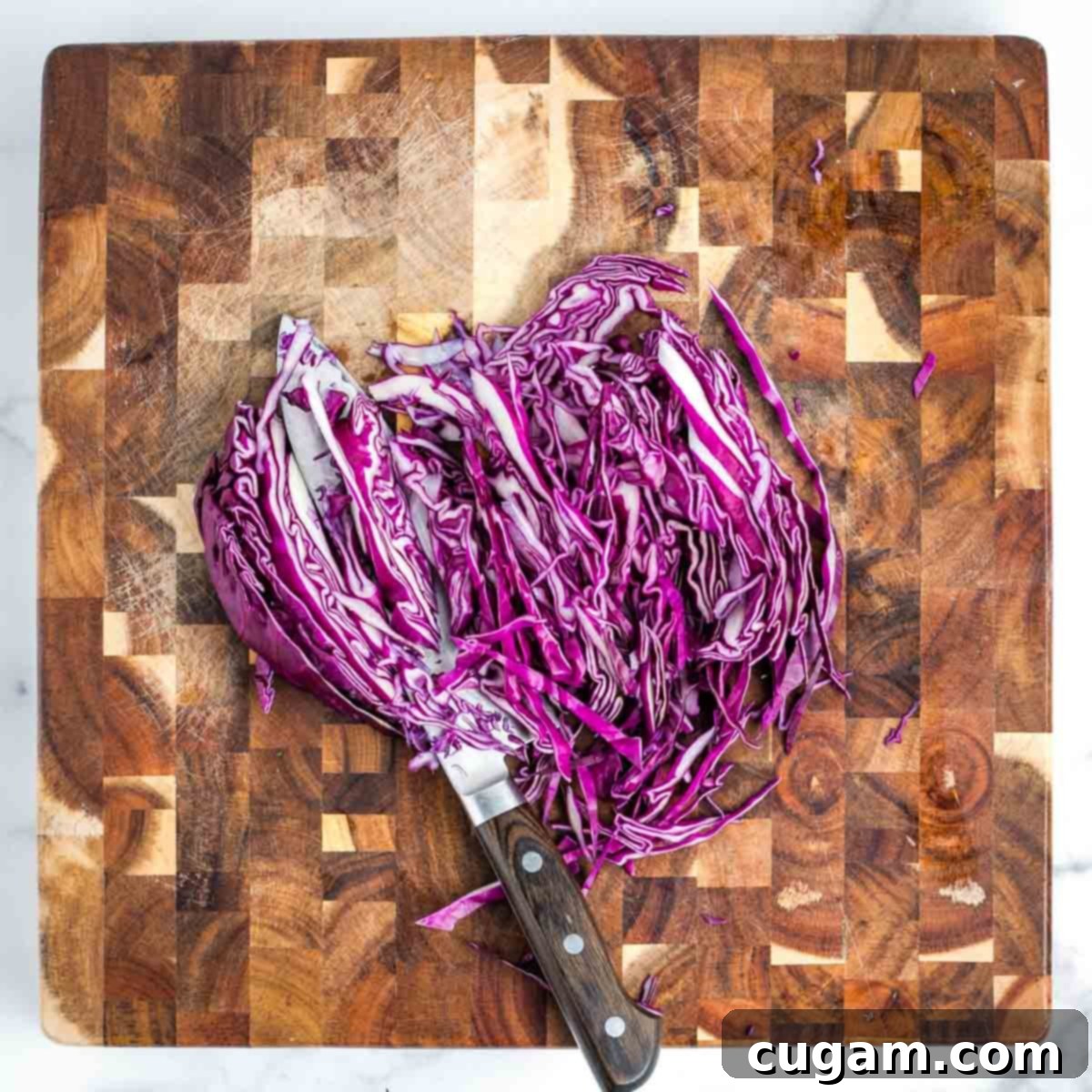
Depending on the size of your cabbage, use either a quarter or an eighth of a head. Lay the cut side down and thinly slice it into fine ribbons. For ultimate convenience, you can also purchase pre-shredded cabbage from your local grocery store’s salad bar.
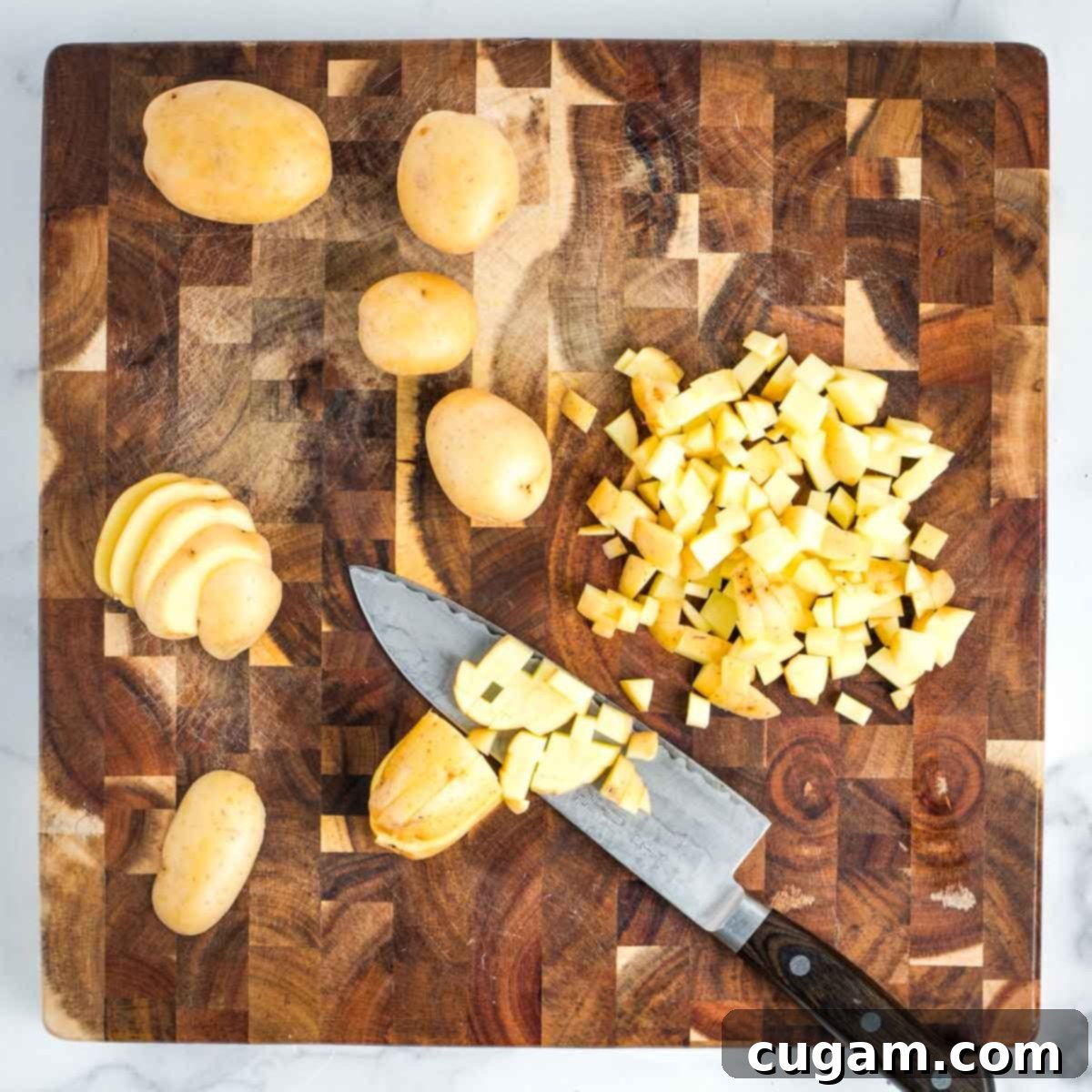
Slice the potatoes into thin rounds or planks, then turn and cut them into strips. Finally, cut across the strips to create small, uniform cubes. Remember, the smaller and more consistent your dice, the quicker and more evenly your potatoes will cook and crisp up.
Cooking Up Your Perfect Vegan Potato and Veggie Hash
With all your colorful vegetables and perfectly diced potatoes prepped, it’s time to bring this delicious vegan hash to life! The key to a great hash is patience and proper heat management. Heat a heavy skillet – ideally cast iron for superior heat retention and even cooking – over medium-high heat. Let the pan get sufficiently hot before adding any ingredients.
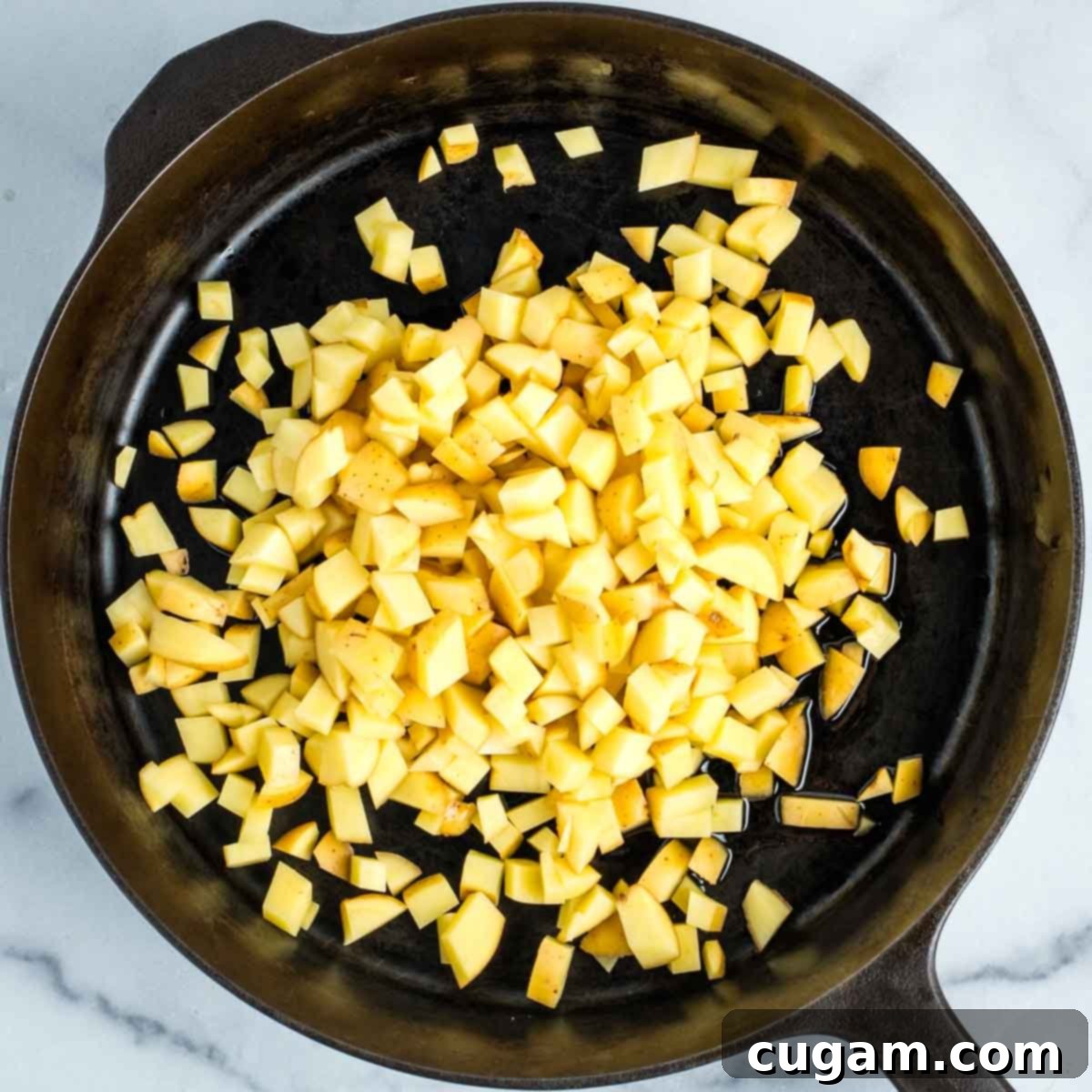
Once your skillet is piping hot, swirl in the olive oil. Immediately add the diced potatoes. Stir them well to ensure each potato cube is evenly coated with the oil. Then, resist the urge to stir! Leave them undisturbed for 2-3 minutes. This crucial step allows a beautiful, crispy, golden-brown crust to form, which is essential for a truly great hash.
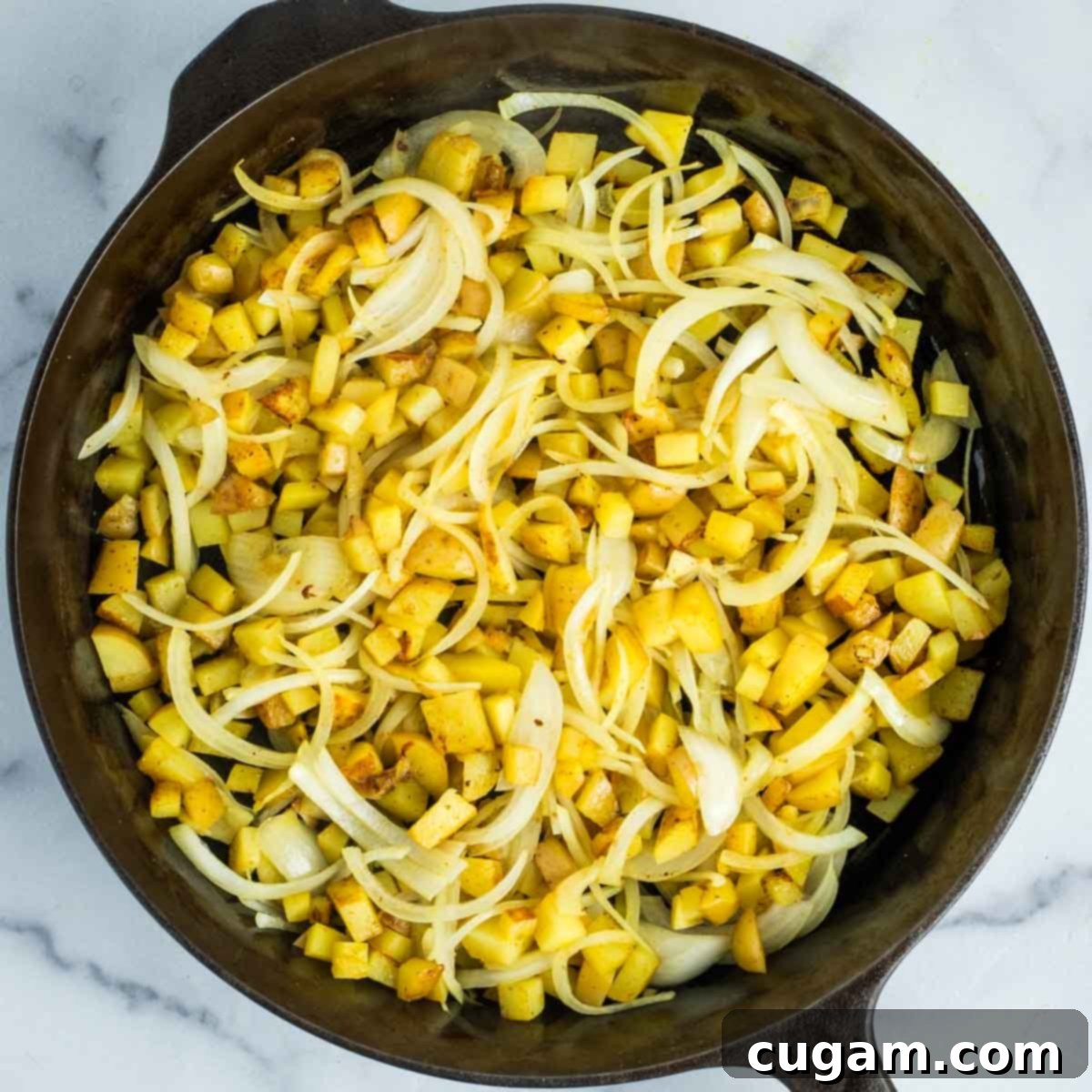
After the potatoes have started to brown, add the thinly sliced onions to the skillet. Stir everything together to coat the onions with the oil and mix them with the potatoes. Again, allow them to cook undisturbed for a few minutes, letting them begin to soften and caramelize. If you notice the pan becoming too dry, add 1-2 tablespoons of water or vegetable broth to prevent sticking and aid in deglazing, then stir.
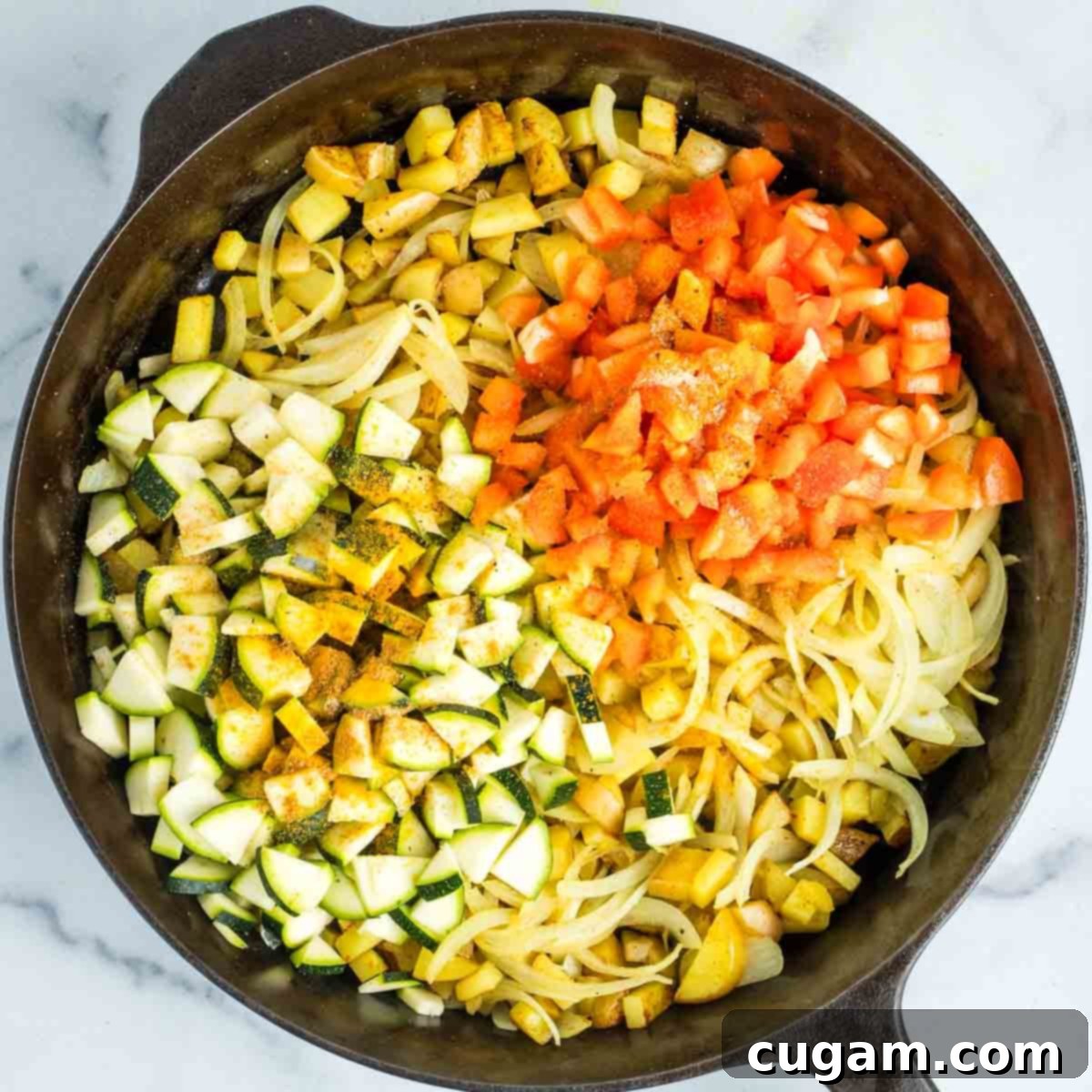
Now, gently place the chopped zucchini and red bell pepper onto the potato and onion mixture in the skillet. Evenly sprinkle your chosen spices – cumin, turmeric, and garlic powder – over the vegetables. This layering helps ensure the spices distribute well and infuse into the veggies.
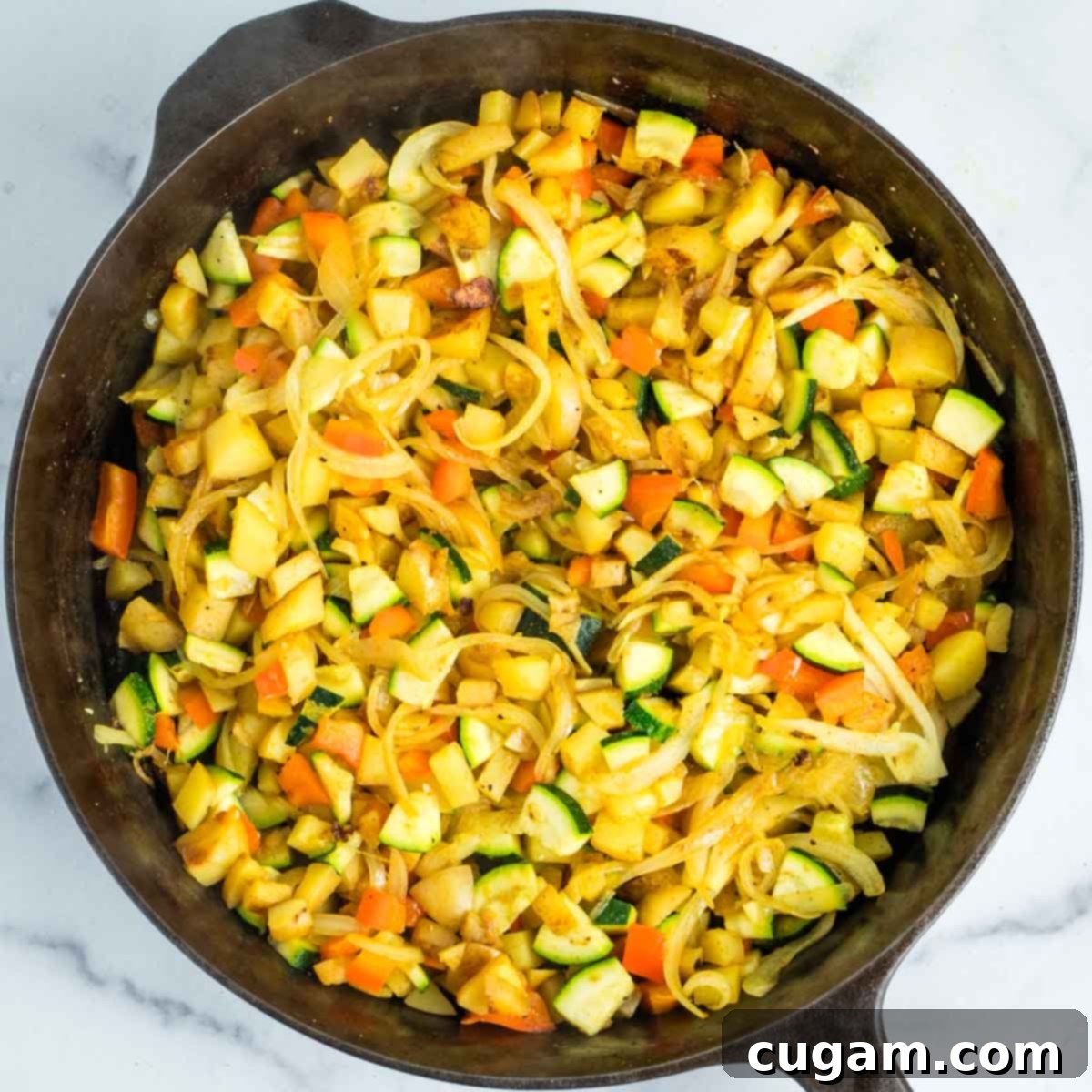
Mix all the ingredients well, ensuring the spices coat every piece of vegetable. Add 1-2 tablespoons of water as needed to moisten the skillet, especially if it seems dry or if anything is sticking. Allow this mixture to cook for another 2-3 minutes, stirring occasionally to ensure even cooking and prevent burning, letting the vegetables begin to soften.
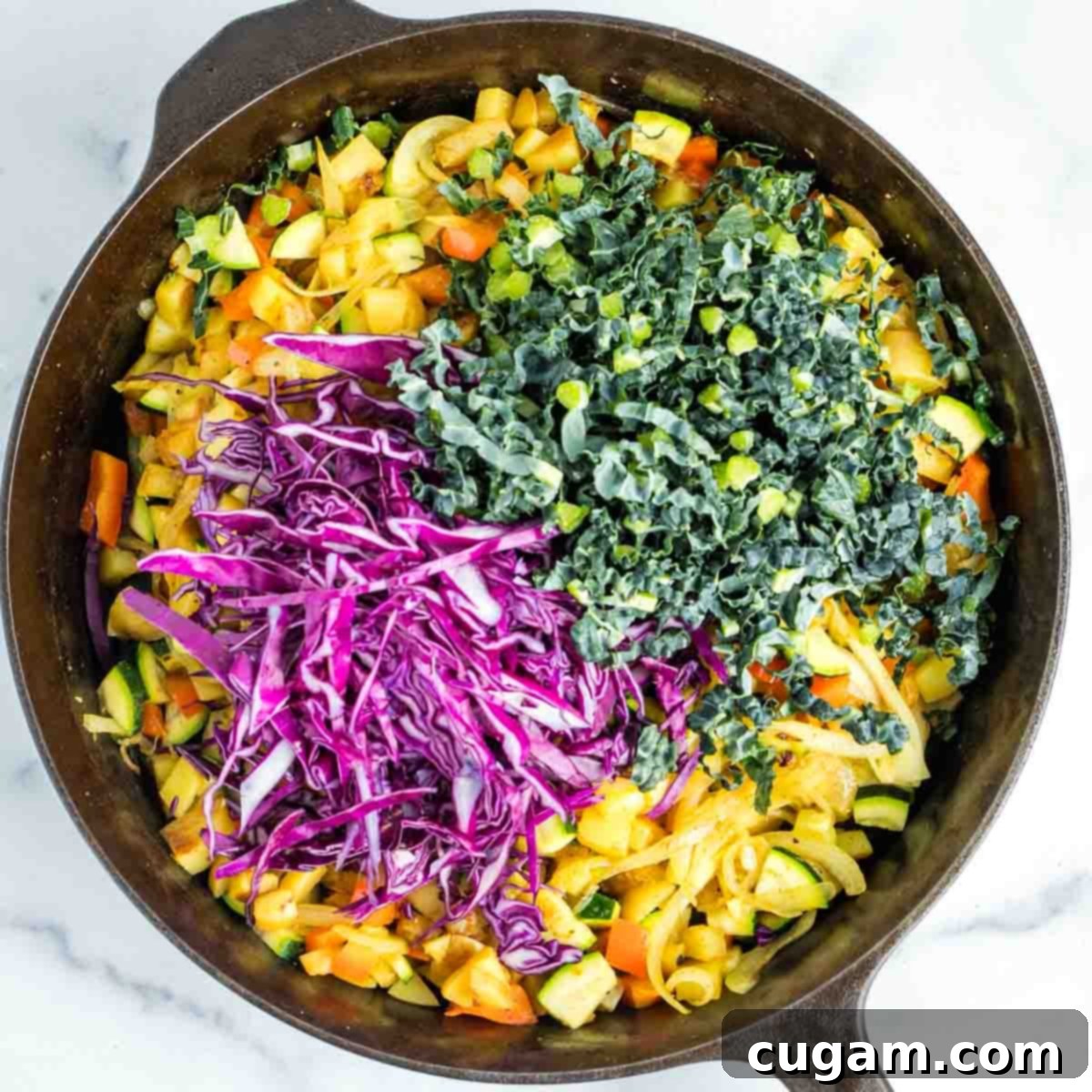
Finally, incorporate the thinly sliced kale and cabbage into the skillet. Stir thoroughly to combine with the other vegetables. If the pan appears dry, add another 1-2 tablespoons of water to create a little steam, which helps the leafy greens wilt. Continue to cook, stirring occasionally, until the kale and cabbage are tender-crisp to your liking.
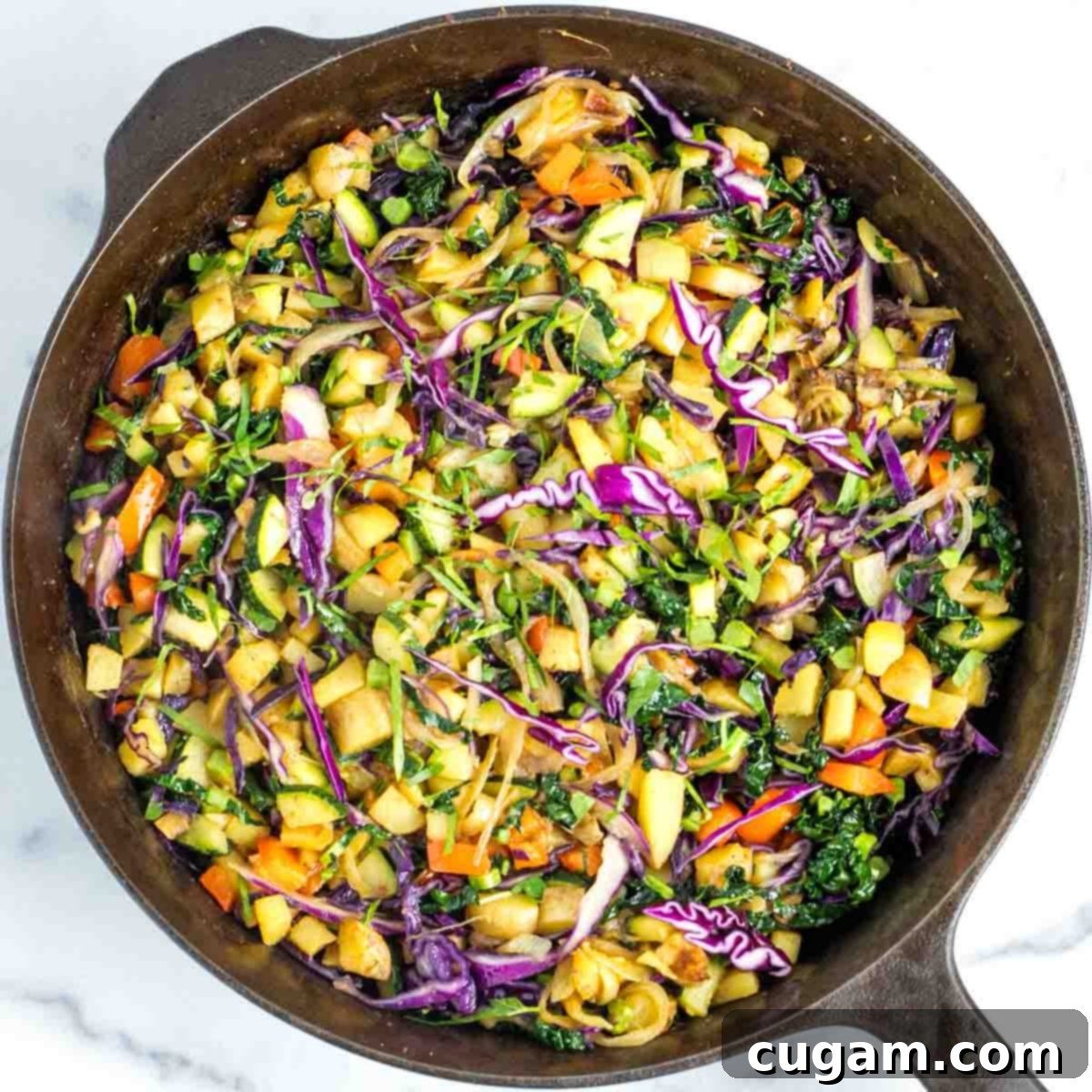
I personally prefer my cabbage to be more al dente, retaining a bit of crunch, so I turn off the heat once it’s just barely wilted. Once all vegetables are cooked to your desired tenderness, taste the hash for seasoning. Adjust with more salt and pepper as needed, or sprinkle with fresh parsley or cilantro for an added touch of freshness. Serve your delicious vegan potato and veggie hash warm and enjoy!
Debra’s Pro Tips for the Perfect Vegan Skillet Hash
Achieving the perfect vegan potato and veggie hash is all about technique and a few key insights. Here are some of my top professional tips to ensure your hash is always a delicious success:
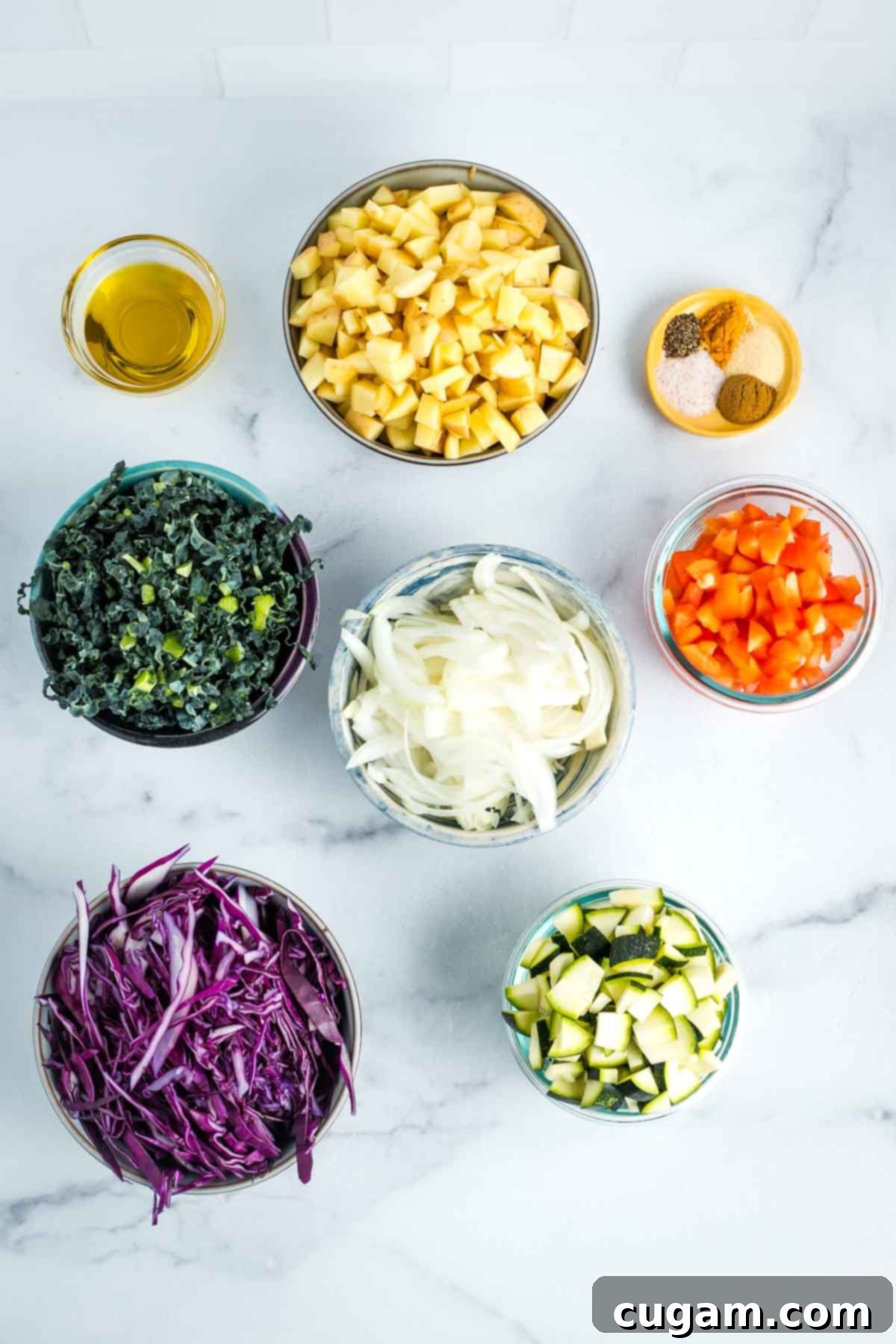
- Start with a Sizzling Skillet: Always ensure your skillet is thoroughly hot before you add any oil or vegetables. This high initial heat is crucial for achieving that coveted crispy exterior on your potatoes and helps prevent sticking.
- Embrace the Undisturbed Cook: For optimal caramelization and browning, especially with the potatoes and onions, allow them to cook undisturbed for a few minutes after each addition. Resist the urge to constantly stir; let that beautiful crust form!
- Invest in the Right Tools: A heavy-bottomed pan, particularly a cast iron skillet, is your best friend for making hash. Cast iron provides excellent, even heat distribution, which is key for crispy potatoes. Pair it with a sturdy metal spatula to effectively scrape up and flip your hash.
- The Water Trick is Your Secret Weapon: Instead of continuously adding more oil if your pan starts to dry out, add 1-2 tablespoons of water or vegetable broth. This helps to deglaze the pan, release any stuck bits (which are packed with flavor!), and creates steam to cook the vegetables without adding unnecessary fat.
- Cut Potatoes Last (or Soak Them): To prevent potatoes from oxidizing and turning an unappetizing brown hue, chop them just before you’re ready to cook. If you need to prep them ahead of time, submerge the cubed potatoes in a bowl of cold water; just remember to drain and thoroughly pat them dry before adding to the skillet.
- Seeking Umami Satisfaction? If you’re looking to reduce breakfast meats but still crave that savory depth, thinly slice shiitake mushrooms and add them to the skillet at the very beginning with the potatoes. Their rich, earthy flavor and meaty texture will add a wonderful umami boost to your hash. Other great additions for umami include nutritional yeast or a dash of tamari.
- Don’t Overcrowd the Pan: Cooking in batches if necessary, or ensuring your pan isn’t too full, allows steam to escape and encourages browning. An overcrowded pan will steam the vegetables rather than crisp them.
- Season Throughout: Don’t wait until the very end to season. A little salt and pepper after adding the potatoes and onions, and then again after the bell peppers and zucchini, helps build layers of flavor. Always do a final taste test before serving.
Did you know commenting and rating recipes is one of the best ways to support your favorite food bloggers? If you made this recipe, please consider a five-star rating below and leave a comment. Also, please share your photos on Instagram by tagging me @dkhealthcoach and using the hashtag #debraklein! Your feedback and shares truly help our community grow.
📖 Recipe
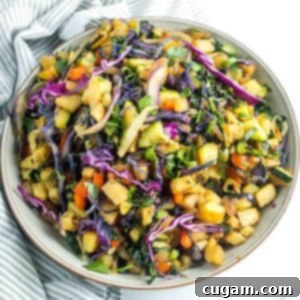
Vegan Potato and Veggie Hash
Rate this Recipe
Pin Recipe
Equipment
-
Cast iron skillet
-
Metal Spatula
Ingredients
- 2 tablespoon olive oil
- 1 lb. yukon gold potatoes small dice
- 1 small onion sliced thin
- 1 small zucchini diced
- 1 red bell pepper diced
- ⅛ head of red cabbage
- 2 leaves lacinato kale sliced super thin
- ½ teaspoon cumin
- ½ teaspoon sea salt
- ¼ teaspoon garlic powder
- ¼ teaspoon turmeric
- ¼ teaspoon ground black pepper
- ½ cup water
Instructions
-
Chop all veggies before you begin, cutting the potatoes last, so they don’t begin to oxidize. I like to cut the kale, cabbage and onion into super thin strips and the zucchini, bell pepper and potatoes into small diced cubes.
-
Heat a heavy skillet over medium-high heat.
-
Add the oil and when it starts to heat up, add the potatoes. Stir to coat with the oil. Evenly distribute the potatoes into the skillet and leave them undisturbed for 2-3 minutes while they start to brown.
-
Stir well and add the onion into the pan. Stir again to coat onion with the oil and leave the onions to cook and begin to caramelize. If the pan is dry, add 1 tablespoon of the water and mix. Otherwise, leave undisturbed.
-
Continue to add vegetables in order of how long they’ll take to cook. IF using same veggies as I did, it will be potatoes, onions, zucchini and bell pepper, cabbage and kale. After each addition, mix well, leave undisturbed, adding 1-2 tablespoons water, as needed to keep pan from drying out.
-
This entire process should take about 10 minutes. I added the spices after adding the zucchini and bell pepper. Honestly, you can add them after any addition of vegetables, stirring well to evenly distribute and coat the vegetables.
-
When all the veggies have been added and have sufficiently cooked/wilted, turn off the stove and mix well. Taste for seasoning, adding more salt and pepper as desired. Sprinkle with fresh herbs and serve warm.
-
Store in an airtight container in the fridge for up to a week. Reheat on the stovetop in a heavy skillet until just heated through (less than 5-minutes), or in the oven at 350 for 10-15 minutes.
Notes
Nutrition
Note
The nutrition calculations were done using online tools. To obtain the most accurate representation of the nutritional information in any given recipe, you should calculate the nutritional information with the actual ingredients you used. You are ultimately responsible for ensuring that any nutritional information is accurate, complete and useful.
